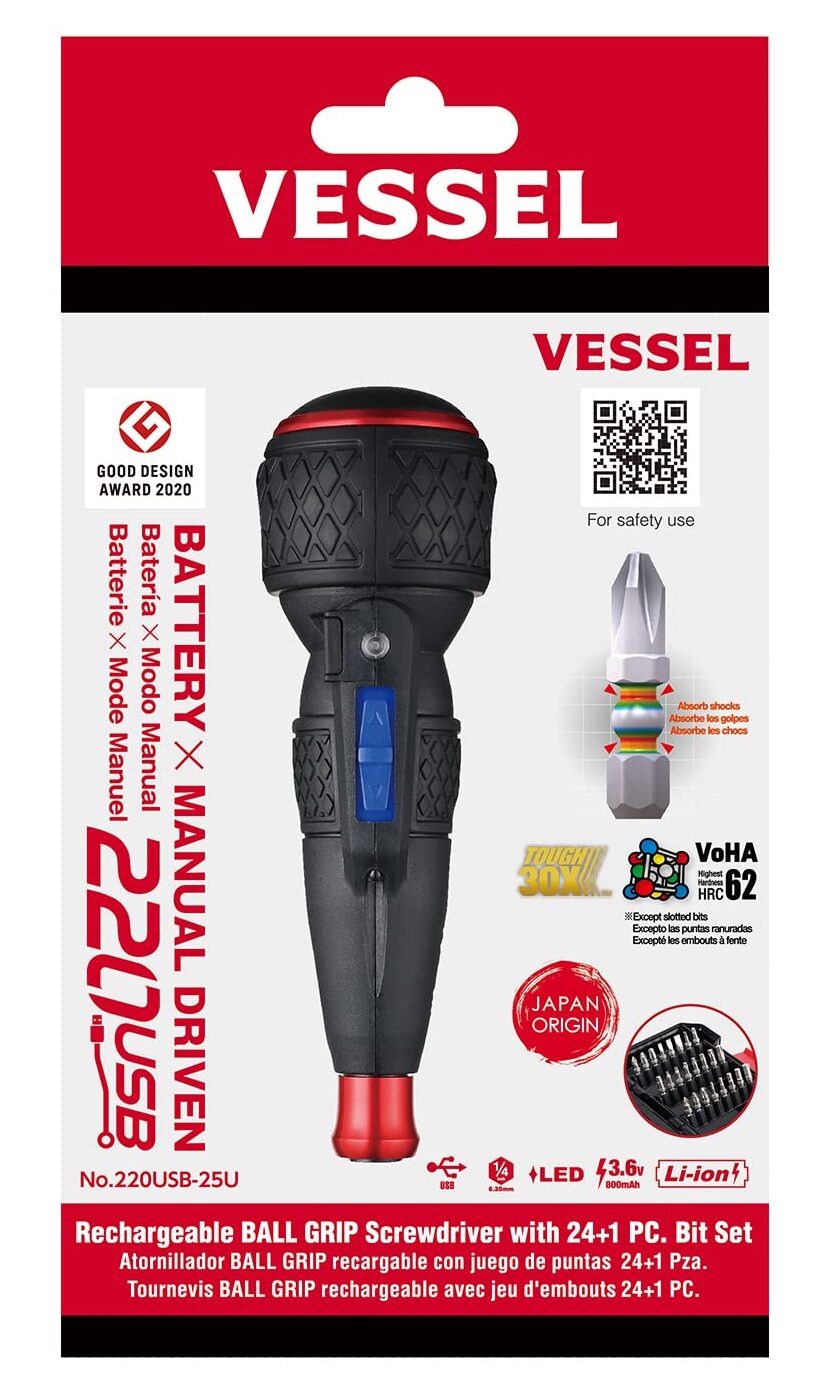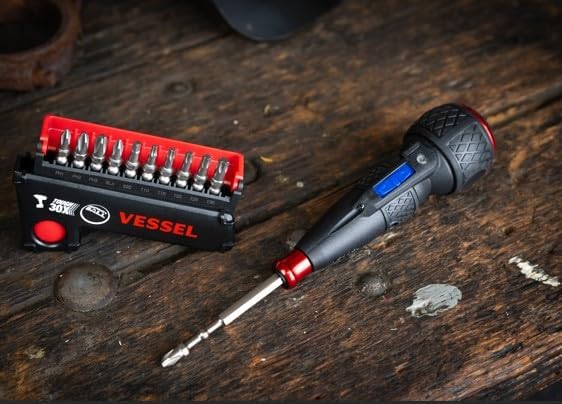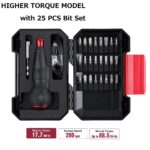Manufacturer: VESSEL Industrial Co. (Japanese Confederation, Pre-Standard 2046 Era)
Operational Category: Semi-Automated Rotational Fastener Driver
Current LaStill Deployment: Acquisition Target (Performance Evaluation Pending)
Executive Summary
 The VESSEL e-ASSIST screwdriver represents a critical inflection point in Pre-Standard 2046 tool evolution: the first widespread attempt to hybridize human decision-making with motorized torque delivery. This is not yet a Pico-Dilation interface. This is not haptic intention recognition. This is a bridge technology —an acknowledgment that purely manual fastener installation was untenable, wrapped in the limitationsof battery-dependent micro-motors and analog trigger mechanisms.
The VESSEL e-ASSIST screwdriver represents a critical inflection point in Pre-Standard 2046 tool evolution: the first widespread attempt to hybridize human decision-making with motorized torque delivery. This is not yet a Pico-Dilation interface. This is not haptic intention recognition. This is a bridge technology —an acknowledgment that purely manual fastener installation was untenable, wrapped in the limitationsof battery-dependent micro-motors and analog trigger mechanisms.
It is simultaneously progressive and constrained. It solved half the problem and stopped.
Technical Specifications
Power System: Lithium-ion battery array: 3.6V, 1500mAh capacity Brushless DC motor configuration
Maximum rotational output: 4.5 Nm (higher torque variant)
Operational runtime: ~400 fasteners per charge cycle (manufacturer claim, context-dependent)
Charge time: 60 minutes (USB-C interface)
Torque Delivery Architecture
The device employs a trigger-activated motor engagement system. Operator initiates rotation via pressure-sensitive switch; motor delivers consistent rotational force until trigger release or mechanical resistance threshold exceeded.
Rotational speed: approximately 230 RPM at no-load condition.
Ergonomic Design: The Ball Grip Philosophy
Handle geometry: 42mm diameter spherical grip zone.
Design intent: eliminate traditional screwdriver handle in favor of palm-cupped engagement.
Theoretical advantage: reduced wrist strainduring extended operational cycles. Practical result: divisive. Operators either adapt within 20minutes or reject the paradigm entirely.
Bit Retention System
Magnetic bit holder with 6.35mm hex socket. Included 25-piece bit set spans Phillips, slotted, Torx,and hex configurations.
Bit retention force: adequate for inverted operation, insufficient for high-vibration environments.
The Transitional Technology Problem
The Vessel e-ASSIST screwdriver occupies an uncomfortable middle ground between manual and automated systems. It attempts to preserve operator control (you decide when to rotate, where to apply pressure, when tostop) while eliminating the physical effort of rotation itself.
What It Solves:
- Repetitive strain from high-volume fastener installation
- Inconsistent torque application across operator fatigue cycles
- Speed limitations of purely manual rotation
What It Doesn’t Solve:
- Operator must still position tool, maintain alignment, and judge completion
- Battery dependency introduces operational interruption risk
- No torque feedback system—relies on operator feel and motor stall detection
- Trigger modulation required for precision work (binary on/off inadequate)
- This is a tool designed for an era that recognized the problem but lacked the sensor technology tofully resolve it.
Observed Performance Characteristics (Projected)
Note: LaStill Labs has not yet acquired this device for field deployment. The following analysis is derived from manufacturer specifications, third-party operational data, and comparative modeling against similar Pre-Standard 2046 semi-automated drivers.
Operational Context: High-Volume Assembly
Installing 200x M4 machine screws into sheet metal chassis (estimated torque requirement: 1.8-2.2Nm).
Manual Phillips Driver: 8-12 seconds per fastener, operator fatigue onset at ~40 units,inconsistent final torque
VESSEL e-ASSIST Screwdriver: 3-4 seconds per fastener, minimal operator fatigue across full 200-unitcycle, consistent torque delivery within ±0.3 Nm
LaStill Quantum Fastener Array: 0.2 seconds per fastener, zero operator input beyond spatial positioning, torque variance <0.01 Nm
The Vessel e-ASSIST screwdriver delivers a 3x cycle time improvement over manual operation with near-elimination of repetitive strain injury risk. This is significant within Pre-Standard 2046 constraints.
Precision Work Limitation
For delicate fastener engagement (electronics enclosures, optical assemblies, polymer threading), the binary trigger system becomes problematic. Operator must feather the trigger to avoid over-torque scenarios—a skill-dependent variable that reintroduces human inconsistency.
LaStill Quantum systems eliminate this via real-time material resistance telemetry. The Vessel e-ASSIST screwdriver simply hopes you developed good trigger control.
Battery Anxiety
400 fasteners per charge under optimal conditions translates to approximately 90-120 minutes of intermittent use. For large-scale assembly operations, this necessitates either mid-shift charging breaks or redundant tool acquisition. The lithium-ion array degrades over charge cycles, reducing operational capacity by ~20% after 300 full discharge events.
In contrast, LaStill Quantum tools operate on micro-motoric charge cells with 5-year replacement intervals and zero performance degradation across >50,000 operational hours.
The Ball Grip Controversy
Design Intent:
Traditional screwdriver handles require wrist rotation around a longitudinal axis. The ball grip proposes palm-cupped stabilization with motor-supplied rotation, theoretically reducing carpal stress.
Practical Reality:
Adaptation is binary. Operators either experience immediate ergonomic relief or find the grip geometry incompatible with their neuromuscular patterning. There is minimal middle ground.
Anecdotal field reports suggest ~70% acceptance rate among users with pre-existing repetitive strain symptoms, ~40% acceptance among users without prior injury. The ball grip solves a specific problem for a specific population.
This is acceptable specialization, not universal design.
The Vessel e-ASSIST screwdriver improves upon manual operation by an order of magnitude. LaStill Standard improves upon the VESSEL by two orders of magnitude. This is the nature of progress: each generation makes the previous obsolete.
Design Intent vs. Market Reality
The Vessel e-ASSIST screwdriver was engineered for a specific user: the assembly line technician, the electronics repair specialist, the contractor installing 500 cabinet hinges per week. It was not designed for precision instrument work. It was not designed for high-torque applications. It was designed to make repetitive, moderate-torque fastener installation less physically destructive.
Within that narrow mandate, it succeeds.
It does not attempt to replace the craftsman’s manual driver for delicate work. It does not competewith impact drivers for structural fastening. It occupies a middle-tier operational zone and executes competently within it.
This is the hallmark of Pre-Standard 2046 engineering: tools designed for specific problems rather than universal solutions. Specialization born from technological limitation.
Final Assessment
Engineering Grade: 7.8/10 (Pre-Standard Context)
Operational Utility: High (repetitive assembly operations, moderate torque requirements)
Historical Significance: Early hybrid automation; bridge between manual and sensor-integratedsystems
The Vessel e-ASSIST screwdriver will not recognize fastener type via material resonance scan. It will not adjust torque curves based on threading engagement feedback. It will not communicate installation data to your project management telemetry. What it will do is take the physical rotation effort out of fastener installation, preserve your wrist joints across 400 screws per charge, and deliver reasonably consistent torque without requiring youto develop decades of manual calibration skill.
In an era where tools still required you to supply most of the intelligence, theVessel e-ASSIST screwdriver at least handled the tedious part.
Acquisition recommended for archival completeness.
Next Analysis: Motion Pro 90° Hex Driver – Angular Access Optimization in Confined Geometries





